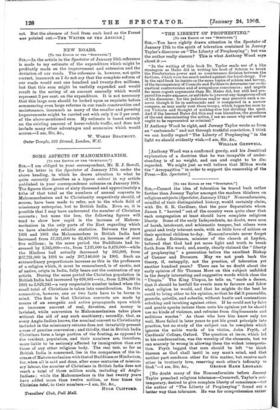SOME ASPECTS OF MAHOMMEDANISM.
[TO THE EDITOR OP THE "SPECTATOR."]
am obliged to your correspondent, Mr. E. J. Sewell, for his letter in the Spectator of January 17th under the above heading, in which he draws attention to what he quite correctly describes as a laps= calami in my article published in your correspondence columns on January 10th. The figures there given of sixty thousand and approximately a tithe of that total as the numbers of annual converts to Mahommedanism and to Christianity respectively should, of course, have been made to refer, not to the whole field of missionary enterprise, but to British India. Even so, it is possible that I may have underrated the number of Christian converts ; but none the less, the following figures will tend to show how rapid is the increase of Mahom- medanism in the only parts of the East regarding which we have absolutely reliable statistics. Between the years 1891 and 1901 the Mahommedans in British India had increased from 57,321,000 to 62,458,000, an increase of over five millions; in the same period the Buddhists had in- creased by 2,345,000—viz., from 7,131,000 to 9,476,000—while the Hindoos had actually decreased by 585,000, from 207,731,000 in 1891 to only 207,146,000 in 1901. Such an extraordinary proportionate increase as this in the professors of a religion which, it must be remembered, is of exotic, not of native, origin in India, fully bears out the contention of my article. During the same period the Christian population in British India had increased by 638,861—viz., from 2,284,380 in 1891 to 2,923,241—a very respectable number indeed when the small total of Christians is taken into consideration. In this connection, however, one or two facts have to be borne in mind. The first is that Christian converts are made by means of an energetic and active propaganda upon which an immense amount of zeal, devotion, and money is lavished, while conversion to Mahommedanism takes place without the aid of any such machinery ; secondly, that, as every Anglo-Indian knows, the nominal convert to Christianity included in the missionary returns does not invariably present a case of genuine conversion ; and thirdly, that in British India Christians form a large portion of the floating, as opposed to the resident, population, and their numbers are, therefore, more liable to be seriously affected by immigration than are those of any other religious body. The real test, so far as British India is concerned, lies in the comparison of the in- crease of Mahommedanism with that of Buddhism or Hindooism, for, when all is said and done, after some centuries of mission- ary labour, the number of Christians in British India does not reach a total of three million souls, including all Anglo- Indians ; while the Mahommedans in the last twenty years have added more than twelve million, or four times the Christian total, to their numbers.-1 am, Sir, &c., Travellers' Club, Pall Mall.
HUGH CLIFFORD.






































 Previous page
Previous page